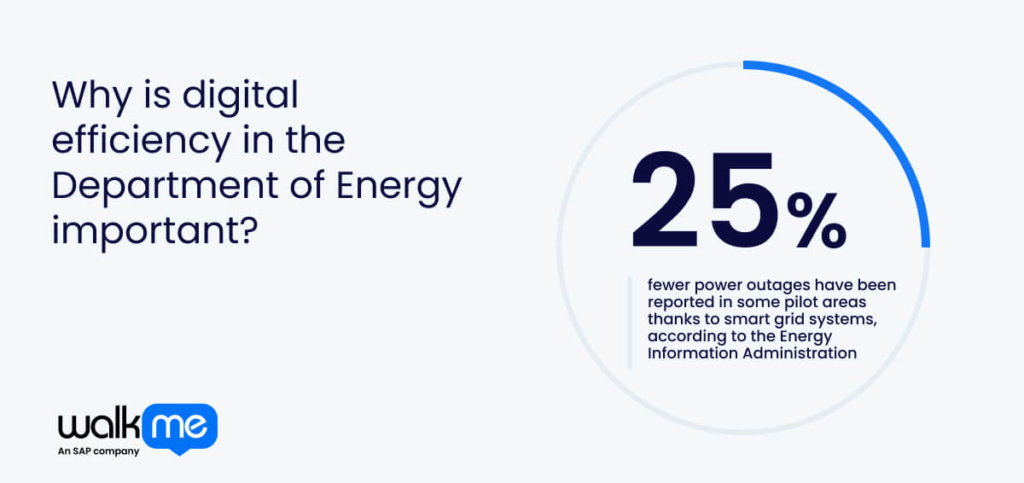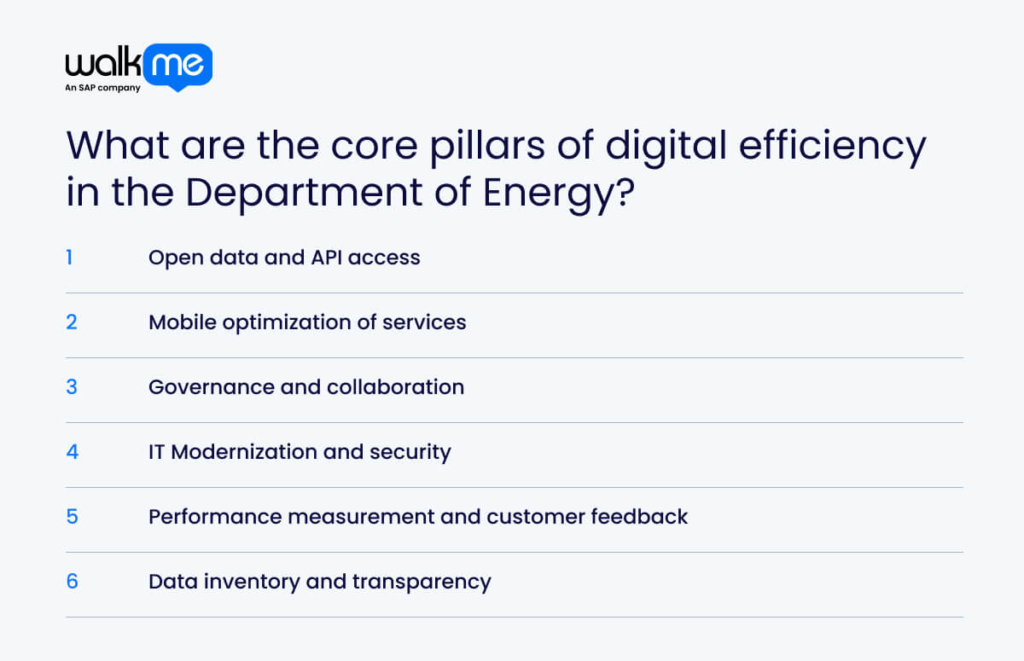Managing energy today means balancing rising demand with limited resources.
The Department of Energy (DOE) uses digital efficiency to track, manage, and improve energy use across federal sites and the national grid.
Currently, the DOE is investing in smart systems that help control electricity flow and identify inefficiencies. This lowers costs and supports the clean energy transition.
This article examines how the Department of Energy leverages digital efficiency through the use of open data, mobile tools, robust oversight, and modern IT.
What is digital efficiency in the Department of Energy?
Digital efficiency in the U.S. Department of Energy means using technology to make energy systems smarter, faster, and less wasteful.
It involves tools like sensors, big data analytics, and automation to improve how energy is produced and conserved. For example, data centers used about 4.4% of all U.S. electricity in 2023, and this is expected to grow with advances in AI.
The Department of Energy uses digital efficiency to cut energy waste and support cleaner power sources. This helps provide reliable energy while protecting the environment and delivering value for taxpayers in the USA.
Why is digital efficiency in the Department of Energy important?

Smart technology makes it easier to track how energy is generated and used. For example, smart grid systems have reduced power outages by nearly 25% in some test areas, according to the Energy Information Administration.
These digital tools also help cut pollution, benefiting the environment and public health by giving communities cleaner air and helping to slow climate change.
With real-time data and automated controls, the DoE can better match energy supply with demand, providing more reliable and cleaner power for both the public and export markets.
What are the core pillars of digital efficiency in the Department of Energy?

Let’s take a closer look at the core pillars of digital efficiency in the Department of Energy:
Open data and API access
The Department of Energy shares data openly and offers easy access through APIs. This helps people and companies develop new tools more quickly. When data flows smoothly between systems, it also leads to smarter energy solutions. Making information available to multiple users encourages teamwork and ensures everything runs efficiently across various energy projects.
Mobile optimization of services
Optimizing DOE services for use on phones and tablets means people can access them anytime, anywhere. Since most people rely on mobile devices, designing with mobile devices in mind helps everyone stay interconnected and react more quickly. This also enhances the sharing and utilization of energy information.
Governance and collaboration
The DOE establishes clear guidelines to guide digital alignment and ensures that everyone follows them. Teams within and outside the agency collaborate, sharing ideas and tools. This teamwork breaks down barriers and helps projects finish on time. It also maintains data integrity and ensures compliance with important laws.
IT Modernization and security
IT modernization and updating old computer systems enable the DOE to handle data more efficiently and utilize new technologies like AI. At the same time, strong security protects important information from hackers. Having modern and secure IT systems means the DOE can continue to work securely and adapt to new challenges as they arise.
Performance measurement and customer feedback
The Department of Energy regularly evaluates the effectiveness of its digital tools by examining key metrics, such as speed and uptime. It also listens to users through surveys to identify areas for improvement. This feedback helps improve services so they meet the real needs of people using them every day.
Data inventory and transparency
The DOE keeps a clear list of all the data it has and where to find it. Sharing this information openly helps others trust and use it correctly. Good record keeping and easy access prevent confusion, ensuring that energy programs run efficiently and informed decisions are made.
What role does digital efficiency play in improving service delivery and stakeholder engagement at DOE?
Digital efficiency is vital for how the Department of Energy (DOE) serves its partners and stakeholders.
- The DOE’s Energy Data eXchange (EDX) platform gives open access to clean energy research. This lets scientists, companies, and policymakers find data quickly, helping speed up innovation and decisions.
- Mobile-friendly tools, such as the Smart Grid Investment Grant portal, enable utilities to track funding and project progress on the go. This cuts delays and makes the process more transparent.
- Shared dashboards connect the DOE with state energy offices to coordinate updates to the power grid. These tools enable quicker outage responses and better energy planning.
- Using real-time data, the DOE can also measure how well services perform. For example, customer feedback on grant programs is collected and analyzed to improve application processes, making them simpler and faster.
- Digital efficiency makes DOE services faster, clearer, and more reliable. It also strengthens partnerships by sharing information openly and encouraging everyone to take part.
How does the Department of Energy manage digital transformation governance?
Managing digital transformation at the Department of Energy (DOE) means making sure new technology is used in a way that’s responsible, clear, and adaptable.
The DOE’s Digital Transformation Office sets guidelines and goals to keep everything on track, while also letting innovators try new ideas.
An example is its Digital Project Review Board, which assesses large technology plans to ensure they align with the department’s mission, from securing the power grid to advancing clean energy.
This board brings together IT experts, policymakers, and engineers to weigh risks, track progress, and ensure resources are used wisely.
Collaborative workshops and employee training sessions help team members learn from each other and avoid repeating mistakes.
This care enables the DOE to move forward safely and efficiently, transforming new digital tools into concrete benefits for energy companies, consumers, and the environment.
What are some examples of case studies that demonstrate DOE digital efficiency in action?
Let’s take a closer look at some examples of case studies that demonstrate DOE digital efficiency:
Alternative fueling station locator API
The Department of Energy’s Alternative Fueling Station Locator API helps people find clean energy stations nearby. This API includes data for over 50,000 stations across the country, from electric charging points to hydrogen and biodiesel stations.
For example, a delivery company can use it to plan routes that avoid running out of power or to direct drivers to refueling locations. This makes traveling with clean energy easier and more convenient. Providing up-to-date, trustworthy information helps reduce emissions, save money, and bring us closer to a clean energy future.
Electricity API by the U.S. Energy Information Administration (EIA)
The Electricity API from the U.S. Energy Information Administration (EIA) delivers detailed, real-time information on electricity production, consumption, and pricing. This tool helps utilities, policymakers, and researchers access reliable data to understand energy trends and plan more effectively.
Tracking the amount of electricity generated from renewable sources enables decision-makers to support cleaner energy choices. The API offers easy access through open data formats and supports custom queries, making it flexible for different users. This transparency improves service delivery by enabling quick responses to fluctuations in energy supply and demand.
What’s next for digital efficiency in the Department of Energy?
The energy sector is bursting with innovation, making it one of the most exciting fields in the digital age.
Breakthroughs, such as advanced solar technologies and green hydrogen, are transforming the way energy is produced and utilized.
The Department of Energy (DOE) must stay agile to keep its lead in this fast-moving energy market. As the world’s population grows, the demand for reliable and clean energy is also increasing.
Because energy is a global priority, digital efficiency will remain essential for the DOE, and the urgency of green energy promises continues to grow.
Now, the DOE must invest wisely in digital adoption and lead the shift toward a cleaner, smarter energy future.
FAQs
Digital efficiency speeds up research and development by using real-time data and advanced analytics. It helps scientists test new energy solutions faster and more accurately, reducing costs and time. This boosts innovation, allowing the DOE to create cleaner, smarter energy technologies more quickly and effectively.
Automation reduces manual tasks like data entry and maintenance scheduling. By automating these processes, the DOE frees up staff to focus on strategic work. This leads to faster decisions, fewer errors, and smoother operations, all of which improve overall efficiency in energy management.
With digital tools, the DOE can monitor energy systems in real time, quickly spotting issues like outages or supply disruptions. This allows faster responses and better coordination with partners. As a result, the DOE can minimize downtime and keep energy flowing during emergencies.

